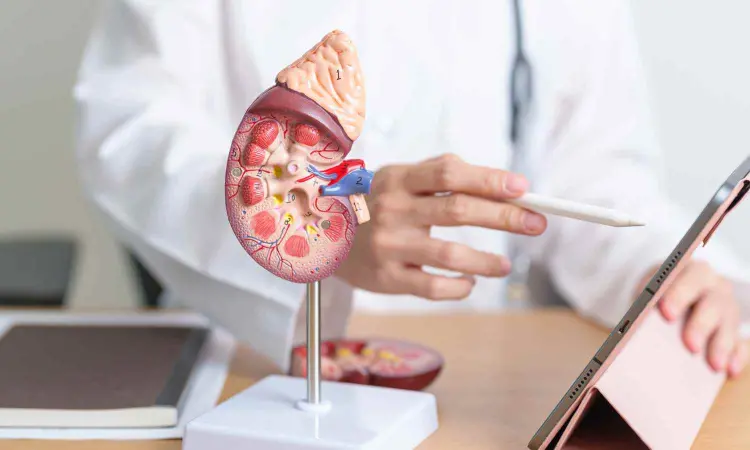- Home
- Medical news & Guidelines
- Anesthesiology
- Cardiology and CTVS
- Critical Care
- Dentistry
- Dermatology
- Diabetes and Endocrinology
- ENT
- Gastroenterology
- Medicine
- Nephrology
- Neurology
- Obstretics-Gynaecology
- Oncology
- Ophthalmology
- Orthopaedics
- Pediatrics-Neonatology
- Psychiatry
- Pulmonology
- Radiology
- Surgery
- Urology
- Laboratory Medicine
- Diet
- Nursing
- Paramedical
- Physiotherapy
- Health news
- Fact Check
- Bone Health Fact Check
- Brain Health Fact Check
- Cancer Related Fact Check
- Child Care Fact Check
- Dental and oral health fact check
- Diabetes and metabolic health fact check
- Diet and Nutrition Fact Check
- Eye and ENT Care Fact Check
- Fitness fact check
- Gut health fact check
- Heart health fact check
- Kidney health fact check
- Medical education fact check
- Men's health fact check
- Respiratory fact check
- Skin and hair care fact check
- Vaccine and Immunization fact check
- Women's health fact check
- AYUSH
- State News
- Andaman and Nicobar Islands
- Andhra Pradesh
- Arunachal Pradesh
- Assam
- Bihar
- Chandigarh
- Chattisgarh
- Dadra and Nagar Haveli
- Daman and Diu
- Delhi
- Goa
- Gujarat
- Haryana
- Himachal Pradesh
- Jammu & Kashmir
- Jharkhand
- Karnataka
- Kerala
- Ladakh
- Lakshadweep
- Madhya Pradesh
- Maharashtra
- Manipur
- Meghalaya
- Mizoram
- Nagaland
- Odisha
- Puducherry
- Punjab
- Rajasthan
- Sikkim
- Tamil Nadu
- Telangana
- Tripura
- Uttar Pradesh
- Uttrakhand
- West Bengal
- Medical Education
- Industry
Study Highlights Ultrasonic Viscoelastic Imaging as a Noninvasive Tool for Identifying Proliferative Lupus Nephritis

China: A recent study highlights the potential of ultrasonic viscoelastic imaging as a noninvasive tool for evaluating proliferative lupus nephritis (PLN), a severe manifestation of systemic lupus erythematosus (SLE) that affects kidney function. Given the limitations of traditional diagnostic methods, such as renal biopsy, this innovative imaging technique offers a promising alternative for identifying and monitoring PLN without needing invasive procedures.
"Ultrasonic viscoelastic imaging effectively differentiated proliferative lupus nephritis from non-proliferative cases, with significantly higher viscosity (Vmean) and dispersion (Dmean) coefficients in PLN. Vmean, along with serum creatinine, showed strong predictive value for PLN. A combined model (AUC: 0.83) outperformed individual markers, reinforcing its potential as a reliable noninvasive diagnostic tool," the researchers wrote in the Journal of Inflammation Research.
PLN is characterized by inflammation and scarring in the kidneys, often leading to progressive renal damage if not detected and managed promptly. The researchers note that conventional diagnostic approaches, particularly kidney biopsies, remain the gold standard for confirming PLN. However, biopsies are invasive, pose procedural risks, and may not always be feasible for all patients. Ultrasonic viscoelastic imaging, which assesses tissue stiffness and elasticity, emerges as a viable alternative to detect kidney abnormalities associated with PLN.
Against the above background, Han Yuan, Department of Ultrasound, First Affiliated Hospital of Guangxi Medical University, Nanning, Guangxi, People’s Republic of China, and colleagues aimed to assess the effectiveness of ultrasonic viscoelastic imaging in predicting proliferative lupus nephritis.
For this purpose, the researchers prospectively analyzed 143 lupus nephritis (LN) patients who underwent kidney biopsies between May 2023 and June 2024, along with 60 healthy volunteers as a control group. Among the LN patients, 90 had PLN, while 53 had nonproliferative lupus nephritis (nPLN). Ultrasonic viscoelastic imaging was used to measure kidney cortex elasticity (Emean), viscosity coefficient (Vmean), and dispersion coefficient (Dmean). Lesion severity was assessed using the NIH 2018 activity and chronicity index. The study examined correlations between viscoelastic parameters, clinicopathological features, and conventional ultrasound findings.
The investigation led to the following findings:
- The viscoelastic parameters (Emean, Vmean, and Dmean) varied significantly among healthy individuals, PLN patients, and nPLN patients.
- PLN and nPLN patients had higher Emean, Vmean, and Dmean values than the control group.
- Vmean and Dmean were notably higher in PLN patients compared to nPLN patients.
- Vmean (OR 89.49), serum creatinine (Scr) (OR 110.57), and anti-dsDNA (OR 1.0) were strong predictors of PLN.
- The combined predictive model had an AUC of 0.83, outperforming any single indicator.
- Peak systolic velocity (PSV) of the interlobar artery influenced Emean.
- Dmean was affected by estimated glomerular filtration rate (eGFR), activity index, and body mass index (BMI).
- Activity index was a key factor influencing Vmean.
- Vmean showed a positive correlation with both the activity index and chronicity index (r = 0.34).
- Dmean also correlated positively with the activity index (r = 0.43) and chronicity index (r = 0.20).
"The findings indicated that ultrasonic viscoelastic imaging serves as a noninvasive tool for predicting PLN by accurately assessing tissue viscosity," the researchers concluded.
Reference:
Yuan H, Chen Y, Wei L, Liao X, Gao Y. Noninvasive Quantitative Evaluation of Proliferative Lupus Nephritis Based on Ultrasonic Viscoelastic Imaging. J Inflamm Res. 2025;18:3269-3281. https://doi.org/10.2147/JIR.S505223
Dr Kamal Kant Kohli-MBBS, DTCD- a chest specialist with more than 30 years of practice and a flair for writing clinical articles, Dr Kamal Kant Kohli joined Medical Dialogues as a Chief Editor of Medical News. Besides writing articles, as an editor, he proofreads and verifies all the medical content published on Medical Dialogues including those coming from journals, studies,medical conferences,guidelines etc. Email: drkohli@medicaldialogues.in. Contact no. 011-43720751


